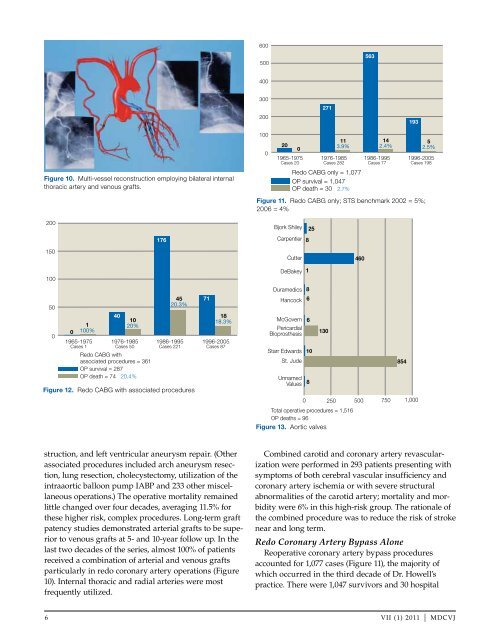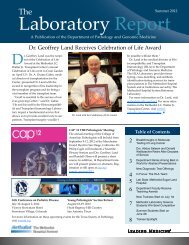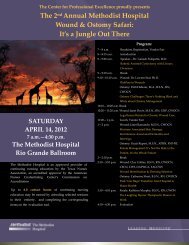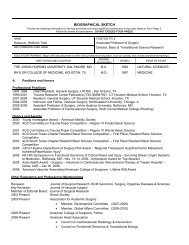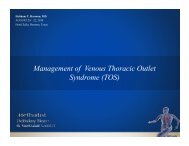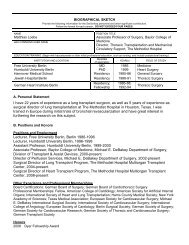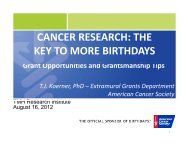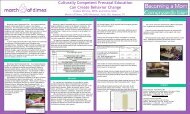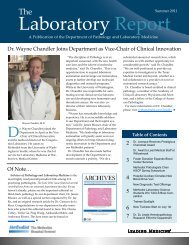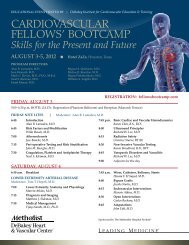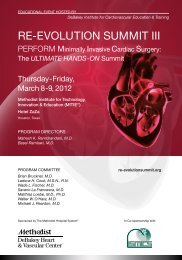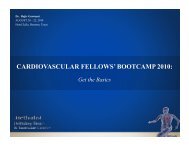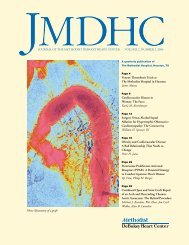DeBAKEy CARDIOvASCuLAR JOuRNAL - Methodist Hospital
DeBAKEy CARDIOvASCuLAR JOuRNAL - Methodist Hospital
DeBAKEy CARDIOvASCuLAR JOuRNAL - Methodist Hospital
Create successful ePaper yourself
Turn your PDF publications into a flip-book with our unique Google optimized e-Paper software.
Figure 10. Multi-vessel reconstruction employing bilateral internal<br />
thoracic artery and venous grafts.<br />
200<br />
150<br />
100<br />
50<br />
0<br />
0<br />
1<br />
100%<br />
1965-1975<br />
Cases 1<br />
40<br />
10<br />
20%<br />
1976-1985<br />
Cases 50<br />
Redo CABG with<br />
associated procedures = 361<br />
OP survival = 287<br />
OP death = 74 20.4%<br />
Figure 12. Redo CABG with associated procedures<br />
struction, and left ventricular aneurysm repair. (Other<br />
associated procedures included arch aneurysm resection,<br />
lung resection, cholecystectomy, utilization of the<br />
intraaortic balloon pump IABP and 233 other miscellaneous<br />
operations.) The operative mortality remained<br />
little changed over four decades, averaging 11.5% for<br />
these higher risk, complex procedures. Long-term graft<br />
patency studies demonstrated arterial grafts to be superior<br />
to venous grafts at 5- and 10-year follow up. In the<br />
last two decades of the series, almost 100% of patients<br />
received a combination of arterial and venous grafts<br />
particularly in redo coronary artery operations (Figure<br />
10). Internal thoracic and radial arteries were most<br />
frequently utilized.<br />
176<br />
45<br />
20.3%<br />
1986-1995<br />
Cases 221<br />
71<br />
18<br />
18.3%<br />
1996-2005<br />
Cases 87<br />
Figure 11. Redo CABG only; STS benchmark 2002 = 5%;<br />
2006 = 4%<br />
Bjork Shiley<br />
Carpentier<br />
0 250 500 750 1,000<br />
Total operative procedures = 1,516<br />
OP deaths = 96<br />
Figure 13. Aortic valves<br />
Combined carotid and coronary artery revascularization<br />
were performed in 293 patients presenting with<br />
symptoms of both cerebral vascular insufficiency and<br />
coronary artery ischemia or with severe structural<br />
abnormalities of the carotid artery; mortality and morbidity<br />
were 6% in this high-risk group. The rationale of<br />
the combined procedure was to reduce the risk of stroke<br />
near and long term.<br />
Redo Coronary Artery Bypass Alone<br />
Reoperative coronary artery bypass procedures<br />
accounted for 1,077 cases (Figure 11), the majority of<br />
which occurred in the third decade of Dr. Howell’s<br />
practice. There were 1,047 survivors and 30 hospital<br />
6 vII (1) 2011 | MDCvJ<br />
600<br />
500<br />
400<br />
300<br />
200<br />
100<br />
0<br />
20<br />
0<br />
1965-1975<br />
Cases 20<br />
Cutter<br />
DeBakey<br />
Duramedics<br />
Hancock<br />
McGovern<br />
Pericardial<br />
Bioprosthesis<br />
Starr Edwards<br />
St. Jude<br />
Redo CABG only = 1,077<br />
OP survival = 1,047<br />
OP death = 30 2.7%<br />
Unnamed<br />
Values<br />
8<br />
1<br />
8<br />
6<br />
6<br />
25<br />
10<br />
8<br />
271<br />
130<br />
11<br />
3.9%<br />
1976-1985<br />
Cases 282<br />
460<br />
563<br />
14<br />
2.4%<br />
1986-1995<br />
Cases 77<br />
854<br />
193<br />
5<br />
2.5%<br />
1996-2005<br />
Cases 198


